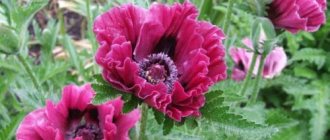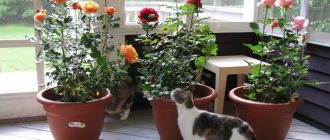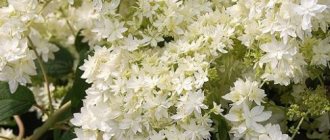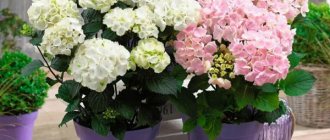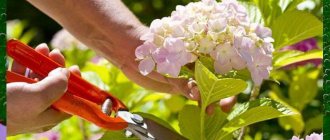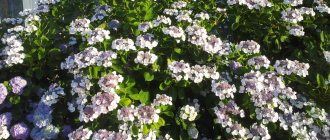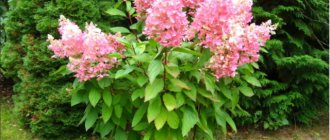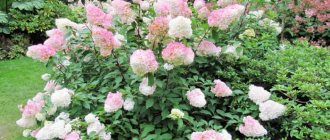Where is the best place to plant hydrangea: choosing a place and soil
To get a lushly flowering bush, you need to choose the right place to plant it. The culture is quite capricious; it prefers bright lighting and does not tolerate shadows. However, direct sunlight is also contraindicated for it. Under their influence, the color of the flowers becomes faded, they look “faded.” Therefore, the bush is planted so that at noon it is shaded. The rest of the time it should be well lit. Lack of light will adversely affect flowering and more. The shaded bush is sick, its inflorescences lose color and become smaller.
Hydrangea does not tolerate cold winds. She gets sick from drafts. Therefore, the place for it should be closed from strong winds. Ideally, this should be the south side of the house, well protected from drafts by a fence or trees. But at the same time, they should not shade the ornamental plant too much.
The culture is demanding on the soil. It should be fertile, rich in organic matter, loose, slightly acidified. Good air and moisture permeability is desirable. The flower does not tolerate heavy alkaline soils. In such conditions, it quickly dies. Abundant watering is desirable, but stagnation of moisture is unacceptable. The bush will not tolerate close proximity to groundwater. The distance to them should be at least 1.5 m. Otherwise, the plant is planted in a flowerbed raised half a meter above the ground.
Caring for hydrangea in the fall - why watering is needed
These flowers love water, without exception, and they urgently need it during the flowering period. And even after the last flower withers, the roots still need a lot of moisture. It will help them restore reserves spent on numerous and large buds. A dehydrated root system will not be able to nourish the above-ground part and will be vulnerable to frost. Therefore, in the fall, you should carry out moisture-recharging watering, “watering” each bush well. The older and larger it is, the more water will be needed.
If there are frequent showers, it is better to cover the soil under the bush with film. The roots that have absorbed a lot of moisture will freeze, which will lead to the death of the entire bush.
On this topic:
BACK
FORWARD
1 of 7
When to plant hydrangea seedlings - in spring or autumn
Many novice gardeners who want to plant hydrangea in their garden ask: when is it better to plant it - in spring or autumn? You can plant in both spring and autumn. And it is better to do this in May or September.
In cold climates, planting is carried out in early spring, where the soil warms up slowly and cold weather sets in quickly. In this case, it is advisable to plant seedlings immediately after winter, but wait until the soil warms up.
It is important to determine the landing time. When planting a leafy plant, always take cues from other plants in your garden. If other bushes are still dormant and the buds have not swelled on them, then it is too early to plant seedlings with leaves. The appearance of buds is a signal that it is time to plant hydrangea seedlings.
When buying seedlings, remember that they previously grew in a greenhouse and can be pampered. Therefore, when planting them in the cold season, the plants may freeze during return frosts or cold snaps. To prevent this from happening, plant seedlings only when the threat of frost has passed.
In summer or autumn, you can plant or replant a bush without fear that they may die during cold weather. But here other problems arise. The plant may die due to strong sun or dehydration. This can be avoided by knowing the characteristics of the plant.
As for replanting a plant, when the location was initially chosen incorrectly. Replant before the buds swell, when the earth has already warmed up. The plant will tolerate such a transplant painlessly. At the same time, they dig up a bush with a large lump of earth and move it to a new place.
Hydrangea paniculata for Siberia
Planting chrysanthemums in open ground in spring
In Siberian climatic conditions, paniculate hydrangea is grown, which is not afraid of frost. The best frost-resistant varieties of paniculate hydrangea for growing in Siberia and the Urals are:
- Phantom – has large inflorescences and variable shade;
- Silver Dollar - white flowers gradually changing to pink;
- Pinky Winky – shrub height up to 2.5 m, flowers are white, change color towards the end of the season;
- Vanille Fraise – changes the color of flowers;
- Lime Light - flowers are greenish in color, towards the end of flowering they become lemon-colored.
In Siberian conditions, it is necessary to select viable seedlings. The shoots should not be long and should not be damaged. For planting, select a lighted area and a slightly acidic environment. The composition of the soil includes leaves, sand, and turf. Plants are planted in late May or early June, when the soil warms up.
Paniculata
Paniculata hydrangea is an unpretentious crop, but when growing in Siberia it is worth considering certain features. Timely circumcision ensures the full formation of culture. In autumn, inflorescences that have bloomed are cut off. The main shoots are cut off, and 3 buds are left on the side shoots. To rejuvenate old bushes, branches are cut down to stumps. Regular watering, mulching and fertilizing will ensure abundant flowering.
In winter in Siberia the temperature drops significantly, so hydrangeas must be covered. If you do not insulate the roots, the plant will die. To do this, use rotted manure, dry leaves or peat.
It is quite problematic to grow hydrangea in Siberian climatic conditions. In the cold climate of Siberia, the plant requires comprehensive and proper care.
Compositions with hydrangea in landscape design
Hydrangea is a popular plant that is used in landscape design. Bright flowers and graceful decorative forms can enliven any area. Paniculata hydrangea looks amazing not only in a single planting, but also in a group arrangement. The spreading crowns of hydrangea will decorate the garden plot as a hedge. The bush as a decoration must be properly shaped. So that it attracts attention not only during abundant flowering, but also in the spring as part of the decor.
A hydrangea bush planted in the central part of a green lawn will add bright colors to the design of the garden plot. If there is an artificial pond on the site, then a hydrangea planted on the shore will be amazingly reflected in the water.
For group planting, hydrangea bushes are planted in different sizes and varieties. The bright colors of the bushes will complement each other beautifully. Using shrubs of different sizes, you can create a tiered composition.
Tree hydrangea lends itself well to shaping. These varieties are mainly used in single plantings.
Hydrangea combines well in compositions with ferns, geraniums, cereals, lilacs, ivy and other plants.
Plant in the landscape
Hydrangea and hosta
A wonderful duet - hydrangea and hosta - will add brightness and uniqueness to any garden. There are a huge number of hosta varieties. Hosta blooms for several years. It is unpretentious and grows actively in any area. The basal foliage of the plant resembles an air cushion, which has many shapes and colors. Varieties with light-colored or gray leaves will look more expressive.
Hydrangea garden
Hydrangea is popular among many gardeners for its decorative qualities. Using different varieties you can beautifully decorate your garden plot. By experimenting with different shades of the plant, you can create a masterpiece that will captivate with its unique and beautiful appearance. An elegant hydrangea will look majestic at the front entrance. For compact varieties, a good place is the perimeter of the lawn or the area along garden paths. Tall varieties can be planted along the fence.
Garden decoration
If a gazebo is installed on the site, then hydrangea planted around the entire perimeter will add romance.
Hydrangeas are valued by gardeners for their variety of shapes, huge palette of colors, unpretentiousness and abundant flowering. With proper care, the plant grows spectacularly and delights with its gorgeous flowers.
Bulgur Mistral, 5 kg
651 ₽ More details
Bulgur Mistral, 5 kg
651 ₽ More details
Mashed potatoes
How to choose a good hydrangea seedling for planting
The choice of planting material is a responsible matter, because the quality of the seedling determines the survival of the plant in a new place, normal growth, beautiful and lush flowering in the future, as well as life expectancy. However, you can obtain planting material yourself - by cuttings.
Advice! It is best to buy garden hydrangea seedlings in nurseries, garden centers or specialized stores that have good reviews and a reliable reputation.
At points of sale you can find two types of planting material:
- A hydrangea seedling with an open root system (OKS) is cheaper, and it is possible to carefully examine the condition of the root system.
- and with a closed root system (ZKS) - it costs more than the first option, but its survival rate is higher, and it is also more convenient to handle and replant. Ideal for beginner gardeners, and this type of planting material can be planted even in summer.
General rules and tips for choosing a quality hydrangea seedling for planting in the fall:
- The general condition of the planting material is good and healthy. The shoots, bark, and trunk have no damage, no signs of disease, no cracks
- A good seedling should have a developed root system. This is easy to check for planting material with OKS. But if you are interested in the option with ZKS, then you need to carefully remove the plant from the pot - the roots should entwine the earthen ball (if this is not possible, then inspect the drainage holes at the bottom of the container, the roots should be visible from them).
- The root system has no traces of mold, rot, damage, or suspicious growths. The smell of mold emanating from the roots should also alert you (perhaps unscrupulous sellers removed the mold in advance). Also, the roots should be moist, elastic, and not dry. To check this in a seedling with ZKS, you also need to carefully pull it out of the pot with a lump of earth and look.
- The above-ground part should be healthy; the seedling should have 2-3 shoots that grow symmetrically to the trunk. However, if the planting material looks a little crooked and not symmetrical, but other criteria are normal, then you don’t have to be afraid to buy such a specimen: in the future it will be possible to straighten it with the help of pruning.
By the way! If you bought a hydrangea seedling with an open root system (OKS) before planting, then you need to take care of its storage. To do this, plant it in a container with acidic soil. Afterwards water moderately.
But storing a seedling with a closed root system (ZRS) is much easier: you just need to periodically water the plant before planting it in open ground.
When is the best time to plant hydrangeas in spring?
So, you have firmly decided that you want to grow this wonderful shrub on your site. But you don’t know exactly when it is better to plant garden hydrangea in open ground in the spring, in what month? The optimal time for spring planting of seedlings is in April and early May.
The suitable time may differ in different regions due to different climatic conditions:
- In the middle zone (including the Moscow region) - you can plant in mid-April.
- In Siberia, the Urals, and the Leningrad region - at the end of April or beginning of May.
- In the South (Krasnodar Territory (Kuban), North Caucasus) - early April.
An excellent assistant in determining favorable and not so favorable times for the procedure are the moon cycles. Thus, the timing of planting a hydrangea seedling according to the Lunar calendar 2022:
- Favorable days: in February: 5, 6, 7, 8, 20, 21, 22, 23, 24, 26;
- in March: 4, 5, 6, 11, 12, 20, 26, 27, 28;
- in April: 5, 6, 7, 19, 20, 21, 22, 23, 24;
- in May: 5, 6, 7, 8, 9, 10, 11, 12, 13, 17, 18, 19, 20, 21, 22, 23.
- Unfavorable days: in February: 14, 15, 16;
- in March: 1, 2, 3, 16, 30;
- in April: 15, 16, 17, 29, 30;
- in May: 14, 15, 16, 28, 29, 30.
Compatibility with other plants
But no matter how good hydrangea is on its own, it is usually grown together with other crops. Ferns are a logical addition to it. Together with them, the exotic guest will reveal all her depth and allow her to “play” in contrasts. You can create ensembles with heterogeneous elements and varied aesthetic content.
Quite often hostas are grown together with hydrangeas. The joint cultivation of hydrangeas with roses, other large flowers and skeletal crops is also practiced. Perennial crops are combined with hydrangeas both in flower beds and flower beds, and simply in plants planted in a group in the garden.
You can also plant ground cover plants designed for moist soil with hydrangeas. Among them are ivy and periwinkle. For greater variety, it is sometimes recommended to use tenacious and pachysandra. If there is an interest in low perennials, a soft cuff is the best choice. Its bright light greenery and the lushness of the cloud-like bush add a “shine” to plant compositions.
We recommend reading:
Planting mustard
Bergenia turns out to be a sharp and even unexpected “companion” of hydrangea. The leaves of this plant reach simply enormous sizes. The tenderness of its flowering will also be an attractive feature. This external combination is especially good in the fall.
You can also create a composition with hydrangeas using cereals. By combining these plants, a modern look is achieved in the garden space. The gaps between large flowers are filled:
- millet;
- miscanthus;
- reed phalaris;
- Hakonechloa.
Such a duet looks so attractive that it is impossible to take your eyes off it. But you can also consider ideas for compositions involving white-flowered crops. Astilbe adds splendor, anemones look vibrant, and physostegia create an unexpected effect. There is no need, however, to limit yourself to white. It is completely acceptable to use other shades and colors.
Lovers of blue compositions should use aconite. Other popular options that pair well with hydrangea include:
- Rogers;
- crocus;
- iris;
- day-lily;
- Volzhanka;
- euonymus;
- bush cinquefoil;
- boxwood
Description and specific features
This perennial highly ornamental shrub comes from China and Japan. Landscape designers are attracted by lush inflorescences of various shades, large bushes of regular shape and lush green foliage. By autumn, the crown begins to turn red, thanks to which the shrub remains decorative at this time of year. Another name for the species is garden hydrangea, because it is she who, despite some difficulties in care, has gained the recognition and love of many gardeners.
Species properties:
- in cold regions it grows up to 1-2 m;
- large inflorescences can be colored lilac, pink, purple;
- loves constant humidity, lack of water negatively affects flowering;
- This type of hydrangea begins to smell abundantly in July;
- the species is not winter-hardy, so you cannot do without shelter for the winter;
Purple Dance variety for open ground and home cultivation - buds form on last year's shoots;
- a significant advantage of this type is the change in color of the petals depending on the acidity of the soil;
- Possible to grow in the garden and on the windowsill.
The list of winter-hardy and double-leaved large-leaved varieties is updated every year, so the gardener always has plenty to choose from. Today there are many options available, differing in the variety of shades, volumes of inflorescences, and degree of terry. Among the remontant varieties, choose David Ramsey, Oak Hill or Avantgarde with leathery foliage. The hydrangeas of the Forever&Ever series are compact.
Requirements for place and soil
This plant does not tolerate direct sunlight, so it is recommended to plant it in shady areas where there is no bright sun. In addition, hydrangea does not like strong winds, so you can choose a place for planting next to a building, but not too close so that the plant does not freeze in winter.
This crop is not demanding on soil fertility, but nevertheless, hydrangea does not tolerate a high content of lime or ash in the soil, because it reduces the acidity level of the soil. To create the most favorable conditions for the development and normal growth of this plant, it is better to plant it in a mixture of sand, humus and peat in a ratio of 1:2:1. Since hydrangea prefers acidic soil, you can use an acidifier.
The color of the flowers depends on the acidity level of the soil and the presence of iron and aluminum in it. If the soil is acidic and these substances are present, the flowers will be blue, and if the soil is low acidity and contains fluoride, the inflorescences will be pink.
Advice! If desired, hydrangea flowers can be given a beautiful blue tint; to do this, before flowering, water the crop with a solution of aluminum alum in the amount of 5 g per 1 liter of water.
Varieties of hydrangea
Hydrangea was brought from Japan to Europe in 1920, and since then it has spread throughout the world. Currently, more than 80 species of shrubs are known. The most common of them are tree-like, paniculate and broad-leaved hydrangeas. They are permanent residents of household plots in our country.
The main differences between popular types of hydrangea are summarized in the table:
| Variety | Characteristic |
| Tree-like | This is an erect shrub up to three meters high with a rounded crown. The leaves are oval-shaped, 6 to 20 cm long, serrated along the edges. Inflorescences with a diameter of 15 cm have the shape of a hemisphere. The flowers change color towards the end of the season from white or cream to pale green. |
| Paniculata | It is a shrub or standard tree up to 10 m high. The leaves are oval-shaped, small in size with jagged edges and dark green in color. The inflorescences are cone-shaped and resemble a panicle, hence the name. The colors of the flowers are very diverse, from white to red. |
| large-leaved | The shrub is no higher than 1.5 m. Large ellipse-shaped leaves have a smooth shiny surface. It has many colors of inflorescences from white to crimson and purple. There are even purple flowers. The plant is heat-loving, so it is recommended to build a shelter for the delicate beauty for the winter. |
Despite the differences in appearance, all types of luxurious perennial shrubs are popular with gardeners and designers.
Amazing feature of hydrangea
This beautiful shrub is capable of changing the color of its inflorescences. The color of lush caps and panicles depends on the level of acidity and composition of the soil. Acidic soil colors the inflorescences of the shrub in a rich blue color. When crushed chalk is added to the soil, the hydrangea may turn pink.
Even in one area, the same variety of a given crop can have different flower colors.
Planting hydrangeas in open ground in autumn
Hydrangeas love acidic soil. Scientists call such plants acidophiles. The lower the acidity, the worse they feel. In alkaline soil, hydrangea will turn yellow and drop its leaves. Therefore, you cannot add alkaline substances to the planting pit: lime, ash, dolomite flour.
Hydrangeas feel great in the following soil composition:
- leaf or turf soil – 2;
- humus – 2;
- acidic high peat – 1;
- sand – 1.
Mix all the components well and add five tablespoons of superphosphate and two tablespoons of any potash fertilizer to one seedling. In the future, it is useful to apply Organic Mix fertilizer for hydrangeas to the soil once every three months to maintain the desired acidity level.
The size of the planting hole should correspond to the volume of the plant's roots in adulthood. For most varieties, a hole of 50x50x50 cm is sufficient.
Planting technology:
- Remove the seedling from the pot along with the soil.
- Place in the center of the hole so that the root collar is at soil level.
- Fill the hole with nutrient soil mixture.
- Pour out at least a bucket of water; if the soil settles, add more.
- Mulch with pine needles or high-moor peat - the layer thickness should be about 5 cm.
Attention. It is important that after planting the root collar is at soil level. When it is buried, frost holes will appear on the branches in the spring and the bark will crack. Paniculata and tree hydrangeas react especially poorly to deep planting.
Landing according to all the rules: choice of location, timing
Growing a plant in the garden begins with choosing a place. It is not recommended to plant hydrangea near trees, as they will take most of the moisture from the soil. The shrub requires partial shade; bright sun damages the crown and dries out the soil. In a constantly illuminated area, growth slows down, the leaves fade, and the inflorescences become smaller. Lighting is better perceived by the plant in the morning, so it is recommended to place hydrangeas on the east or west side. Some varieties prefer to grow in a bright location, but will require plenty of watering. During the peak of the heat, some shading will have to be provided.
Bushes should not be exposed to constant drafts.
The soil for growing must be well-drained. Hydrangeas grow well in nutritious clay areas and poorly in sandstone areas. If there is lime in the soil, any large-leaved variety will grow worse. The soil must be acidified, otherwise chlorosis cannot be avoided. Acidified soil can be collected under coniferous trees.
Bush in the first year of growth in a flowerbed
Seedlings should be purchased in containers; samples with an open root system take root less well. The optimal time for planting a bush in cold latitudes is the beginning of May, when the snow melts and the soil warms up. In the southern regions, you can plant the bush both in spring and autumn. Autumn planting is carried out no later than October, since the plant must have time to adapt before the onset of frost. Seedlings purchased in containers can be planted even in summer, but if it is possible to create light shading for several days.
Preparation of nutrient substrate and agricultural planting techniques
The soil for filling planting holes is prepared from 2 parts humus, 2 parts leaf soil, 1 part turf soil and 1 part river sand. When planting, fertilizers are added to the mixture: 20 g of urea, 25 g of potassium sulfate, 70 g of superphosphate per planting hole.
The acidity of the soil directly affects the shade of the inflorescences. This must be provided for at the time of planting, since it is more difficult to change the pH level afterwards. For pink and red inflorescences, the acidity should be 6.0-6.2 pH. If blue flowers are needed, the acidity is reduced to 5.0 pH by adding aluminum sulfate. To obtain blue inflorescences, several more waterings will be required during the growing process.
Superphosphate
How to plant hydrangea correctly? There are several stages:
- The size of the planting hole should be 0.4 m by 0.4-0.5 m. If the garden soil is acidic and nutritious, then the hole is made small; if it is poor, it is expanded to 0.6 m in depth and in diameter.
- Several bushes should be planted at intervals of 1.2-1.6 m.
- If groundwater lies close, a drainage layer of expanded clay, gravel or broken brick must be laid on the bottom. If the soil in the area is dry, then hydrogel is placed in the hole in the amount of 1 tbsp. l. This will help retain moisture.
- The hole is dug 2-4 weeks before planting and filled with prepared substrate. During the specified time, it will settle and become saturated with oxygen.
- Before transplanting, the pot with the seedling is watered and removed along with a lump of earth. A mound is formed from the soil so that it is convenient to straighten the root system of the plant. As you fall asleep, the soil is slightly compacted.
Growing on an open veranda - The root collar should remain at soil level or 2-3 cm higher (the soil will settle over time). After planting, the bush is watered abundantly (about 10 liters per plant).
The tree trunk circle is mulched with bark, sawdust or peat. The height of the mulch layer is 6-8 cm.
Mulch allows you to maintain an optimal level of humidity, prevents the roots from overheating, and inhibits the growth of weeds. Over time, the mulch layer will decompose and acidify the soil.
Landing rules
The main point in growing hydrangea is proper planting, which includes choosing a planting site, digging a hole and forming the soil. To properly plant hydrangeas, follow the recommendations described below.
The right location is half the success if you want to plant hydrangeas in open ground. The landing site must meet several requirements.
- Moisture. Hydrangea loves plenty of moisture, but does not tolerate too much moisture. Due to stagnation of water, the roots of this plant begin to rot, causing both the flowers and the crown to suffer. A young plant should be watered at least once a week, more often in dry seasons. Avoid planting this plant in lowlands and wetlands.
- Lighting. Soft sunlight promotes the rapid growth of shoots and leaves of the bush and accelerates the flowering of buds. Despite this, overly aggressive sun rays have a negative effect on hydrangea - they cause its leaves to turn yellow and wither. Choose a place where the plant would be in the sun in the morning and evening hours, and huddled in the shade at noon. You should not place hydrangea completely in the shade, otherwise it will not be able to fully develop.
- Shelter. The place for planting hydrangeas should not only be properly lit, but also carefully protected from strong gusts of wind. The ideal place would be where the shrub on one side is protected by a house wall or a dense fence. If this option is not possible, provide the plant with strong support.
- The soil. If hydrangea is really whimsical about something, it is the type of soil in which it will have to grow. It should be rich and nutrient-rich soil, moderately oxidized. Hydrangea loves slightly acidic and acidic soils, but has an extremely negative attitude towards alkaline soils.
- Neighborhood. An important aspect of choosing a place for hydrangea is the immediate vicinity of the future shrub. If we talk about the aesthetic side of the issue, then this plant will look best together with hosta or astilbe. If you want the plant to fully and quickly develop, you should avoid planting it near trees or other shrubs, especially those with a shallow root system. Plants with more developed roots will suck all the moisture out of the soil, and the hydrangea bush will grow underdeveloped and weak.
It is not enough to simply find a place and dig a hole there of a certain size. Preparation of the planting site is also one of the important procedures that can affect the future growth of the shrub.
- Cleaning. After you have chosen the optimal place to plant the plant, clear it of weeds, remove all debris, stones, roots and twigs. For more efficient tillage, you can dig up the area with a shovel. In order to fertilize the soil already at this stage, you can add several buckets of peat to the soil at the time of digging, and then thoroughly loosen everything.
- Dimensions. After you have cleared the area of debris and weeds, start digging the hole itself. For young seedlings no older than two years, a hole of 30 by 30 cm will be sufficient. For older plants over 4 years old, a hole of 50 by 50 cm should be sufficient. Since hydrangea has an extensive root system, the hole should be not only deep, but also wide.
- Distance. If you plan to plant several hydrangeas to create a hedge, you should plant them at least 70 cm apart from each other. For normal planting of shrubs close to each other, leave about 1.5 m of free space.
In order to prepare the soil for planting shrubs as much as possible, you should mix acidic high-moor peat and fertile garden soil in a ratio of 2/3. Peat will raise the acidity level of the soil, which will allow the plant to quickly get used to the new place.
We recommend reading:
Onion peels for the vegetable garden
Seedlings also need to be prepared for planting. If you bought seedlings with ACS, then you do not need to prepare them, but if we are talking about hydrangea with ACS, then the roots of the plant should be soaked in a special stimulating solution to accelerate root formation.
The process of planting hydrangeas will involve several steps.
- 2-3 hours before planting the seedling, thoroughly water the hole.
- Taking care not to damage the root system of the seedling, place it in the hole, straightening its roots so that in the future they grow in several directions. The roots should lie flat in the hole, without bending.
- Using pre-prepared soil from peat and soil, fill the roots of the seedling up to the root collar. Make sure that the soil is distributed evenly in the hole and does not form voids or niches.
- Using a spatula, lightly compact the soil around the seedling's trunk.
- Once again, thoroughly water (depending on the age of the plant - from 1 to 3 buckets per bush) and make sure that the water does not stagnate at the root collar.
- There is a possibility that after watering the soil around the plant may settle a little. In this case, you must use additional soil to level the planting site to ground level.
If you do not do this, excess moisture will always accumulate in the roots of the bush.
Feeding paniculata and tree hydrangea: in spring
Planting hydrangea in spring in open ground
Fertilizers are the main source of useful and nutritious substances. They saturate the soil with chemical elements necessary for active growth and development of the root system. If you systematically feed the shrub, you can expect abundant flowering until late autumn. Fertilizers are applied in several phases:
- the first - in early June, so that new shoots grow;
- the second - in June, for an abundance of buds;
- the third - during flowering (for laying new buds).
Fertilizing hydrangea paniculata in the spring is carried out with complex fertilizers with a high nitrogen content (ammonium sulfate, ammonium nitrate, urea). Before applying fertilizers, the soil is well moistened.
For hydrangea paniculata, a mixture of ammonium sulfate and urea is used to make the foliage grow.
Top dressing
Hydrangea and manure
In the absence of chemicals, slurry is used for feeding. What manure will be used is up to the gardener to decide.
Important! Pure manure is not used for feeding. Too concentrated a mixture or pure manure will cause a burn to the root system.
Cow or horse manure must be diluted with water and mixed thoroughly. The finished fertilizer is diluted with water 1:10. Each bush requires 5 liters of fertilizer.
Feeding with manure
Preparing for cold weather: caring for hydrangea in open ground
After the hydrangea blooms, it’s time to prepare for the cold weather. It is necessary to apply autumn fertilizing, which will help the shrub to go to winter. The applied fertilizers will strengthen the condition of the hydrangea and lay vegetative and flower buds for future growth and flowering next year. Potassium-phosphorus fertilizers are applied to the soil. The amount of watering is reduced and stopped on rainy days. If the days are hot in September, then it is necessary to water the bush so that the plant receives the necessary moisture.
An important crop care activity is pest and disease control. The disease can be caused by waterlogged soil, hard water, dry or rainy weather. Among the diseases, the following should be highlighted:
- powdery mildew;
- gray rot;
- chlorosis;
- rust.
To combat them, special drugs or folk remedies are used. The shrub is susceptible to invasion by insects such as snails, slugs, leaf rollers and other pests. Special means are used to destroy the inhabitants. Disease prevention and timely pest control will ensure active growth of the bush.
Diseases
Pruning and shelter for the winter
Most varieties need shelter for the winter, although the crop is considered frost-resistant. The main requirement is that the covering material should not allow air to pass through, otherwise the shoots of the plant may rot, which will lead to death. For shelter you can use foliage, burlap, roofing felt, spruce branches.
Important! PVC bags and plastic film are not used as shelter. This material does not allow the plant to breathe.
There are several methods of shelter:
- The hydrangea branches are carefully placed on the spruce branches and pressed to the ground with the help of stones. Then the bush is covered with leaves on top and covered with burlap;
- metal staples are used to secure the branches along the diameter of the bush. Spruce branches are laid out on the branches, covered with burlap and generously sprinkled with sawdust. Roofing material is laid on top, which reliably protects the plant;
- you can simply cover it with spruce branches or wrap it in burlap.
Trimming
Any method of shelter can protect hydrangea from frost, the main thing is to remove the shelter in time. So that the plant pleases with its beautiful flowering.
Pruning is also a necessary part of crop care. Pruning is done in the spring, no later than April. When buds appear on the hydrangea, it is time to prune. To form powerful shoots, you can prune the bush generously. Old bushes are pruned more heavily than young plants. After pruning, the hydrangea is fertilized with humus and compost to speed up the formation of shoots. You can apply mineral fertilizers that will have a beneficial effect on the crop.
Shelter
Choosing a place and soil for planting
Hydrangea grows favorably in sunny places. It is better to choose a place where the sun warms in the first half of the day. You should not plant hydrangea next to garden trees with a large crown. Such trees will take up moisture and create shade, and without a humid environment the bush will die. The area must be closed from drafts. It should not be planted near the roofs of houses and buildings; there is a possibility of snow and frost getting on the plant. A wonderful place - hills and hills with high groundwater levels in the area.
Main soil requirements:
- acidity - the higher its level, the richer the flowering will be;
- airtightness - hydrangea loves loose soil;
- humidity – the soil should not be allowed to dry out (mulching is used).
Nutritious soil will ensure excellent growth and abundant flowering. The flowering period of the plant is early June and until late autumn. If the shrub is planted in neutral soil, it will bloom with beige or cream flowers. Pink and lilac flowers predominate in alkaline soil. In acidic soil, the flowers turn a bright blue. Wrong location and soil are the reasons for the non-flowering of the shrub. After six years of age, the bushes are renewed, as the crop stops blooming.
How to plant a plant?
When planting hydrangeas, it is important not only to choose the right place and soil, but also to follow every step of planting.
Hydrangea is planted as a seedling, but you can grow a seedling from seeds. Planting seeds is carried out in the fall, but this method requires more time. After planting with seeds, the shrub needs to be replanted.
Planting seedlings
Planting pit and soil
For young seedlings, the dimensions of the planting hole should be 40x40, for perennial shrubs - 50x50. Each hole is filled with a mixture - soil and fertilizers rich in minerals. Young seedlings have elongated roots, and shoots and dry inflorescences are pruned (if the bush is old). A hill is formed from the soil on which the seedling is located, and the roots are straightened. The hole is filled with the remaining soil without covering the root collar of the bush. Abundant watering is carried out, the soil is compacted and mulched with sawdust or tree bark.
Protection from diseases and pests
Hydrangea has practically no diseases, but if there is insufficient amount of magnesium and iron in the soil, the leaves of the plant begin to turn white. To prevent this phenomenon, fertilizers must be applied on time. By the way, before fertilizers for garden plants were invented, gardeners dug iron into the soil next to hydrangeas - nails, tin cans, and more. Nowadays, there is iron chelate for this.
Spider mites and aphids may appear as pests. Their appearance is signaled by curling young leaves. It is necessary to treat with insecticidal preparations, without relying on traditional methods.
Types of hydrangea
The main types of hydrangea that can be successfully grown in our regions are:
- Large-leaved (garden);
- Paniculata;
- Tree-like;
Video: varieties of tree hydrangea
- Bretschneider;
Video: types and varieties of hydrangeas
What to do with hydrangea after autumn planting: basic care rules
Caring for a shrub after an autumn event is much easier, but there are a number of steps that must be performed correctly and efficiently for normal survival.
So, what are the rules for caring for garden hydrangea seedlings after planting in open ground in the fall?
- After planting, be sure to mulch the planting site. Mulch will perform 2 functions: it will slow down the evaporation of moisture and protect the young root system from the cold. It is recommended to use acidifying elements as mulching material: pine litter, rotted pine sawdust and bark, or high-moor acidic peat. The optimal layer thickness is 5-7 centimeters.
Important! The mulch should not come into contact with the trunk of the seedling, otherwise it will begin to rot. There should be a distance of about 5-7 cm between them.
- The shrub is moisture-loving, so for effective care the first two weeks after planting you need to water it regularly. The soil should be moderately moist. If it rains often, the number of waterings can be reduced.
- In regions with cold winters, for example, the Middle Zone (Moscow region), Siberia, and the Urals, it is very important to protect and shelter young hydrangea from frost. To do this, you must first remove all remnants of leaves and inflorescences (if any). Then, at the first frost, you need to pour sphagnum moss (about 30 centimeters) into the center of the bush. If it is not possible to use moss, then you can put leaf humus, pine bark, rotted sawdust, and peat.
- Also, at the first frost, you need to add mulch to the tree trunk circle so that its layer is 15-20 cm. In this case, mulch will protect the root system from freezing.
- After this, you need to carefully tie the shoots of the bush with twine so that they are not damaged due to snow, wind, or heavy rain. Then wrap it in burlap, spunbond or spruce branches.
Important! When the frosts end, in the spring you need to immediately remove the cover and mulch to prevent damping off of the bush. Then put a new layer of mulch - about 7-9 cm.
Shrub care in the first year of life
How to grow hydrangea in the garden? The charming hydrangea seems strong and resilient only at first glance. In fact it is a delicate flowering specimen. It requires special care in the first 12 months after settling in a permanent place.
Planting chrysanthemums in open ground in spring
The plant will try to bloom after rooting. This should not be allowed. Inflorescences are removed in the first year. It is recommended to cut them off with a sharp, disinfected knife before the tiny buds begin to gain strength. This procedure will help the garden queen to correctly distribute her energy, namely, to spend nutrition on the growth of the bush, and not on weak flowering.
The shrub is often attacked by pests. Especially tender young leaves can be loved by snails, slugs, and spider mites. In case of such problems, it is recommended to spray the foliage with a soap solution and use insecticides. Suitable:
- Ecokiller;
- Storm;
- Ulicide, etc.
Proper watering
Translated from Greek, the name of the shrub means a vessel with moisture. This definition perfectly characterizes the plant. Hydrangea loves water, but does not like stagnant moisture. Caring for hydrangea involves proper watering.
The irrigation scheme is as follows:
- At least 15-20 liters of water should be spent on each bush.
- Add water every 5-8 days, depending on weather conditions. If the summer is dry, then water every 2-4 days.
- The water must be settled and soft.
- After watering, the soil is loosened. For this, garden tools are used, for example, a hoe.
Top dressing
When planting, a young bush is supplied with all the necessary elements. Urea, humus, humus, and superphosphate give especially good results. Which of these fertilizers is chosen is not particularly important.
Important! The next feeding is carried out only 2 years after planting. This is the case if the hydrangea develops well. If its leaves have withered or its growth has slowed down sharply, you can add organic matter and mineral supplements.
Care during the flowering period
Lush inflorescences in some species appear in May and disappear only in autumn. How to care for hydrangea during flowering? Experienced gardeners only recommend monitoring timely watering and protecting the plant from pests.
A flowering bush should not be left without timely watering.
Care during the rest period
Home hydrangea lives according to climatic laws. It blooms in summer and goes dormant in autumn or early winter. At this time, sanitary pruning is carried out, the pot is placed on an insulated veranda, and removed underground or in the basement. The perennial needs +10 degrees and darkening. Watering is minimal and not abundant. Once a month will be enough.
Preparatory activities for wintering
In regions where winters are harsh, all dried inflorescences are removed from the hydrangea and then mulched with peat. Some gardeners are in favor of mandatory shelter, others believe that it can be done without it.
Growing large-leaved hydrangea involves digging it up for the winter and placing the cuttings in the basement. Other species most often do not need digging.
If you understand all the intricacies of hydrangea, how to plant and care for it, you can become the owner of a long-flowering perennial. At the same time, learning how to handle a bush is not difficult. The main thing is to choose the right place, plant correctly and follow the watering schedule.
When to plant phlox in open ground in spring
Hydrangea after flowering
The faded plant needs to be prepared for wintering. Seedlings grown in containers must be moved indoors. For flowers growing in open ground, you need to pick off wilted flowers, because when wet from rain and snow, they will become very heavy and can break branches. You will also need to hill the base of the bushes high enough and cover the surface of the soil around them with a layer of mulch, which will help protect the root system from freezing. The most frost-resistant species are ground cover and paniculata. The stems of such plants become completely lignified before the onset of autumn, which helps them tolerate frosts more easily, even if they are not covered (when grown in areas with mild winters). You can also leave tree hydrangea uncovered for the winter.
Features of regional planting
Botanists have been able to adapt hydrangea to different climatic conditions, so many varieties are planted and grown not only in the southern regions, but also in the central and northern regions. When choosing seedlings, special attention should be paid to the winter hardiness of the selected specimen. It is best to buy shrubs with well-developed roots. The site itself should have enough light, but with protection from direct rays and wind.
The optimal time for transplantation is spring, but in areas with mild winters the autumn period is suitable, the main thing is that the weather is stable and warm. To prevent the buds from freezing in winter, shelter should be provided. In the southern regions, high hilling of the plant is suitable for this; in cold regions, serious measures are needed.
To do this, the shoots are bent, secured with staples to the ground, and a layer of peat is poured on them. Everything is covered with film and spruce branches.
If cultivation is carried out by seeds, then it will be necessary to create the right conditions to prevent freezing during growth and development. It is not recommended to use open ground, since frosts can occur even in spring, especially if we are talking about the Urals or Siberia. Rational regional planting involves the selection of a specific variety or type of plant.
Important! Hydrangea, especially in summer, is often attacked by aphids and snails that feed on shoots, flowers and buds. Therefore, you should regularly inspect the bush for the presence of pests.
For example, for the Moscow region they recommend:
- Hydrangea petiolaris - a vine that grows up to 25 meters and can entwine trees and buildings.
- Variegated.
- Winter Surprise - a “new” varietal, notable for its leaves, which become bright purple closer to autumn.
- Ampelous hydrangea.
Climbing varieties are more suitable for planting near a house or fence, as well as near fruit trees . Proper care will help you get a strong bush that will be an excellent decoration for your garden or home. The creeping type of plant is chosen to create a hedge. Petiole hydrangea can overwinter painlessly and is not afraid of diseases and pests. It is propagated by layering or petioles, for example the seed method, but weaving will begin 3–4 years after planting.
